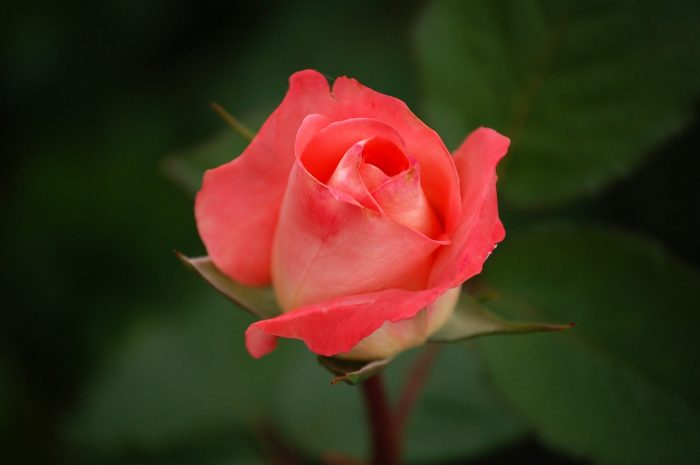Of course, creating and managing a beautiful rose garden requires careful planning. You need to decide on the appropriate location for your roses, what colors will best suit your taste and complement the exterior architectural design of your home.
Most important is whether the flower type you choose will bring out the effect you’re trying to create.
But first, assess your garden’s micro-climate to ensure that the soil pH and your area’s climatic condition favors the types of roses you want to have in your rose garden. Rose flowers tend to flourish in fertile, well-drained soil with an almost neutral pH value of 6.5 (though a range of 5.5-7.0 is still okay). Since they love the sun, an open location would be ideal to allow the flowers at least six hours of sunlight a day.
However, there are some that do well in the shade. So, it all depends on your preferred flower type, location, and design of your garden.
Types of Roses
Roses are among the longest existing flowers with their history dating back to millions of years ago. They’re the most preferred choice of flowers when it comes to home décor projects and gifting purposes as they come in different colors, sizes, and also exhibit different fragrances—attributes that explain their multi-purpose nature.
The intended purpose or meaning often depends on the rose color you choose. For instance, red roses are popularly known as a symbol of love; while the white, green, light pink and dark pink roses symbolize purity, life, gentleness, and gratitude respectively.
Below are some of the most common types of roses:

Hybrid Tea Roses
Being the most popular type of roses, hybrid roses are commonly known for their high centered blooms which are beautifully positioned on the long stems thus providing an impressive view even from afar. Unlike other plants, this plant’s foliage doesn’t cover the canes’ lower parts hence the barelegged look.
Their usual height ranges from 4-6 feet, and they mostly prefer mild climates for optimized growth and blooming process. Be sure to offer your hybrid teas special protection if you reside in regions with severe winters.

Miniflora Roses
They’re known to be among the smallest in the roses’ family with bushes that grow only up to three feet tall hence good candidates for pot gardens but can still make perfect edges for your flower borders.
Compared to miniatures, mini flora roses tend to have larger foliage and blooms. Miniature roses usually grow to a height not more than fifty cm and produce flowers that are less than five cm across. Nevertheless, they’re also ideal for edges and pot gardens.
Climbing Roses
Just as the name suggests, these roses exhibit long climbing canes (usually thorny) hence require support as they can’t maintain an upright position by themselves.
They can stretch for more than 20 feet long and may take a maximum of two to three years to mature and adequately fill in. As opposed to ramblers, climbers bloom repeatedly and vary in sizes to suit your garden needs.
The blooming can be enhanced by allowing the newly growing canes (usually emerging from the plant’s base) to mature in length while ensuring that the major ones stay in a horizontal position. The practice helps promote the growth of new shoots and fuel the flowering process.

Shrub Roses
These cold-hardy roses are a unique type of the cherished rose family as they contain genes that help protect them against pests and diseases, hence require minimal care.
You can choose to grow them upright or simply as ground covers depending on the shrub type you select. Remember that just like the other roses, shrub roses also come in various sizes, colors, and shapes to enable you to determine what works for you.

Want to enjoy the unfading beauty of roses? There you go—shrub roses rebloom throughout the growing season to ensure a colorful garden thus enhancing your curb appeal.
Tree Roses
Tree roses may be from any rose category including the hybrid teas, shrubs, miniatures, or even floribundas.
The roses’ buds are generally grafted onto a single sturdy rose cane to form a small tree—which is a way to bring out the mixture of your favorite flower colors.
You can either have the rose in a container or grow it in the garden as it allows under-planting. Regardless of your chosen method, the rose still grows to form a beautiful bush of flowers at the top of the stem.
Planting Rose Bushes
Though most home gardeners view the planting and maintenance of rose bushes as a demanding and challenging task, it’s indeed easy and fun, especially if you’re out to reap the endless benefits of gardening—rose growing.
Of course, roses require some special care to bloom as expected; however, you don’t need to be an expert to achieve all that. Here are some great hints on how to grow that beautiful rose bush.
1-Choose your preferred rose type
There are several options to choose from—which include the climbers, miniatures, tree roses, floribunda, polyanthas, and grandifloras.
However, hybrid tea rose bushes are the most popular considering their unique blooming style. They bloom abundantly in the spring; all through to the fall season when they again undergo a grand rebloom process.
Most gardeners also prefer them for their long, straight, and strong stems—which can hold the big flowers up hence often used as cut flowers.
Hint: Choose easy-to-maintain roses that won’t require a lot of care, and if possible, visit a flower nursery to gather more details about the rose bush you intend to plant. Get to know the color, size, and of course, the fragrance.
2-Prepare the soil for planting
Loamy soil is always the best when it comes to rose growing. It drains well and retains moisture long enough to ensure the plants stay nourished. This preparation is necessary because the soil is made up of relatively equal amounts of sand, clay, and silt—components that ensure moderation of every vital requirement to ensure vigorous rose growth.
However, if you are unable to access loamy soil, consider adding composted manure or compost to the earth to help aid the soil’s drainage, moisture and water retention properties. The practice also helps loosen the soil texture, which is ideal for the thriving of rose plants.
Though optional, throwing in some superphosphate in the planting holes helps to nourish the plants’ root system and ensure their proper establishment. Remember soil loosening before planting also applies to areas with loamy soils—so ensure you use a spade or a fork or whatever tool works best for you.
Once you have the soil ready for planting, consider adding some organic mulch (2-3 inch layer to the soil’s surface) that slowly decomposes to continuously provide the necessary nutrients while also improving the soil’s texture.
3-Planting the roses
Before you plant, select a garden spot in an open site where the plants can receive at least 5-6 hours of the morning sunlight a day. This careful selection is to ensure enhanced growth and also to keep the leaves dry. Dry leaves help prevent diseases.
Note: In as much as most roses prefer full sun or partial shade, others thrive only in the shade, so ensure smart site selection and plant wisely. Be sure to dig a much bigger planting hole (wider than the root ball) to avoid bunching the roots together—in the name of planting. A spacious hole, of course, with loose soil, enables the plant roots to grow horizontally and next to the soil surface for more oxygen.
The planting distance for standard rose bushes should be 80-100cm apart, while that of ground cover rose bushes and climbing roses should be 35-45cm and 1-2m apart respectively.
When it comes to potted rose bushes, a good draining pot is ideal to ensure the soil isn’t saturated but adequately moisturized for the plant’s survival.
Finally, water your roses thoroughly after planting to keep the roots off any fungus infections.
4-Watering
Roses prefer “dry feet,” so ensure you don’t over water them. Three times a week is sufficient during the summer season, and no watering is required during the rainy season.
If possible, do the watering in the early hours of the day to allow time for the leaves to dry hence protecting the plants from powdery mildew—a fungal disease. As you well know, wet conditions are always perfect thriving zones for fungus; which is why you have to avoid late evening irrigation.
You also don’t want to splash water onto the leaves while watering, and so ensure you direct the water to the ground level.
5-Mulching
Add a 2-4 inch layer of grass clippings and or shredded leaves around the base area of your roses to help enhance their growth and conserve the water. Note: Never pile mulch against the plants’ stem—ensure a safe distance of 2-3 inches; to protect the plant from pests and any possible rot case.
Pruning Roses
Pruning benefits your roses in several ways including:
- Improving air circulation.
- Reducing your roses’ vulnerability to pests and diseases through the removal of dead, broken, and diseased canes.
- Promoting new growth.
- Helps roses acquire the desired shape.
- Pruning enhances flowering.
Knowing when and to prune your roses is the number one step to ensuring the above benefits.
When’s the right time to prune your roses?
Of course, the different rose varieties call for different timing when it comes to pruning. For instance, the reblooming rose varieties such as the hybrid teas are better off pruned in the spring when the buds are just breaking dormancy. However, you need to be keener with the climbers and any other rose type that blooms once a year. Such roses should only be pruned after flowering, and don’t require heavy pruning in the early spring. This is because they need the previous year’s grown wood to bloom.
Hint: Sometimes it may be difficult to discern the best pruning time for your roses at the outset, but don’t fret. Just keep your eyes on the buds—once you notice any swelling sign, go ahead and prune.
But consider removing any diseased or dead parts of the plant as soon as you notice them, to curb the damage from spreading to the rest of the rose plant.
How to Prune: The essential tools and effective pruning techniques
Rose stems are usually thorny and can easily prick your hands when you prune bare-handed. Therefore, get elbow-length leather gloves that are easy to work with, and of course, some safety goggles to protect your eyes from any falling branches.
You must also have the right pruning shears to avoid crushing the stems. Bypass pruners are more effective than the anvil-type since they’re sharp enough and cut like scissors. Anvil-type, on the other hand, tends to damage the stems.
Also, get the long-handled loppers alongside a pruning saw to quickly cut the hard old stems.
The pruning process
Begin by removing all dead or weak rose stems. But first, ensure the tools you use are clean to avoid spreading diseases. You can do that by periodically dipping the shears or any other pruning tool you’re using in a 70% alcohol solution.
Start pruning from the plant’s base.
Ensure your rose bush is more open at the center to allow more light and adequate air circulation to the plant. This also helps prevent diseases. Your pruning cuts should be about a quarter-inch and above a leaf bud that’s facing out towards the exterior of the plant.
While removing the dead, weak, or diseased wood, ensure you cut until you’re able to see the white inside part of the cane. However, consider sealing the after-pruning cuts and holes using a dab of glue to keep borers away.
Borers hatch from wasps’ eggs and can weaken the canes with time hence causing them to break off in windy climates.
Caring for Your Rose Garden
Roses are easy-to-care-for plants provided you follow the primary tasks involved—which are planting, fertilizing, watering, pruning, and winterizing. Since we’ve discussed the planting, watering, and pruning of roses, here is what you need to know about fertilizing and winterizing.
Fertilizing Roses
Organic blend fertilizers work best for roses as they offer a wide range of plant nutrients including vitamins, amino acids, minerals, micro and macronutrients required for the plants’ nourishment.
Dissolve a spoonful of Epsom salt in water and add it to the plant in spring to help promote strong canes.
Be sure to feed your roses consistently before and all through the blooming period for better health and more blooms.
However, if you don’t have the time or can’t keep up to the roses’ feeding demands, then you can opt for wild or the traditional roses or even those that only bloom once in a year since they don’t require regular fertilizing.
Winterizing Roses
Protecting your rose bushes from the harsh cold weather elements is simpler and easier than you thought. All you need is shredded bark or leaves, pruners, and some compost.
Avoid pruning your roses in the early fall to allow for the seedpods to form naturally as they get ready for the cold season.
Consider adding some compost around the roses before the ground freezes to help protect the plants from potential frost damages. Do that immediately after the first few touches of frost in the fall (preferably after the first frost).
Cut any overly long canes from the roses to protect them from wind damage.
You can as well add some mulch to moderate winter soil temperatures. Here are some organic mulches you can use, how to apply them, and of course their pros and cons.
Mulching options
Wood chips
They’re inexpensive and work well with perennials including your rose bushes. Directly apply 1-2 inch layers around the plant while ensuring the mulch doesn’t come into contact with the plant. This is to prevent any chances of rot. Though they’re long-lasting and decompose slowly, wood chips draw nitrogen from the soil and hence not suitable for annual gardens.
Shredded leaves
They’re great winter covers, are lightweight, and readily decompose to enrich the soil with the necessary nutrients. They’re also cheap; however, the decomposition process is too slow for annual gardening. Apply a 1-2 inch layer around the beds once a season, of course, with some space between the mulch and the plants’ stems.
Straws
This material is lightweight, easy to spread, and make great insulators. However, they’re low in nutrients. Shake them onto a clean soil above your ankles and repeat the practice after every 4-6 months. The mounds should be thick enough to deter the growth of weeds.
Pests That Plague a Rose Garden
Conduct regular inspections of your rose garden to catch any early signs of pests and conditions before they destroy your roses. Some of the pests that usually target roses include:
Aphids
These pests reproduce fast and are easy to overlook owing to their small sizes. Signs of aphids include puckered or curled leaves, deformed flowers with streaked petals, and yellowing leaves which regularly drop from the stems. The presence of ants (on the stem) or black mold are also indicators of aphids since the pests produce a sweet sticky substance known to attract ants and harbor the black mold.
Remedy: Consider introducing ladybugs into your rose garden since they love feeding on the aphids. All you must do is spray the bugs around your rose bushes.
Thrips
These tiny insects usually infest roses in hot and dry conditions. And you’ll most likely find them on the light-colored blooms, especially in the shady spots.
They prefer white, light pink, or pale yellow blooms. It isn’t easy to spot them since they mostly hide at the petals’ base.
Signs of their presence include distorted blooms, stuck flower buds (buds don’t open or open partially), and brown-streaked petals.
Remedy: Remove all the damaged blooms and buds and throw them far away from your rose garden. If possible, keep the grass trimmed and ensure the base of the rose plants is free of any grass or weeds.
Sawfly Larvae
Sawfly larvae somewhat resemble caterpillars, but of course, they aren’t caterpillars. They usually move like an inchworm and feed along the leaf midribs; which sometimes extend to the leaf edges.
Remedy: Once you spot them, use a forceful water spray (preferably a hose nozzle) to wash off the larvae from the leaves.
Inchworms
Inchworms, which are caterpillars with legs at the end (both ends) of their bodies with none in the middle.
The two types (spring inchworm and fall inchworm) both affect roses and often hatch in the spring. You’re likely to spot them moving along petals on unopened rose flowers. They eat they move, leaving behind clear evidence of destruction.
Signs of inchworms include unopened buds with rough edges and deformed flowers.
Remedy: Pick off the larvae from the plant and dispose of them carefully. You can as well drop the larvae in soapy water to completely get rid of them. However, spraying with an insecticide is more effective about large infestations. Remember that pruning your roses regularly to enhance the flowering process and also keep pests and diseases away.
The Takeaway on Having a Perfect Rose Garden
Ready for your dream rose garden? Then below is a summary of the rose success tips to get you there.
Choose a site that allows the flowers at least six hours of sunlight a day. The garden can be of any size; however, the spacing should be done as per the rose type.
The soil should be fertile and well-drained. But, consider adding some well-rotted compost manure to the ground before planting. Let the fertilizer stay in the compost pile for some time (at least two months) before you finally use it on your rose garden.
Fresh manure can also do, but in most cases, it will end up burning the rose’s roots. This is because when nitrogen decomposes, heat is produced as a result of the chemical reactions—which then cause the burning effect.
Water your roses often enough to ensure consistently moist soil. However, ensure the foliage stays dry to prevent the spread of diseases. Also, note that the watering frequency dramatically depends on the type of soil, temperature, and the surrounding plants. For instance, weekly watering, with 4-5 gallons, is usually sufficient for roses in temperate climates. That’s when opposed to those planted in hot, windy, or dry areas, or even on sandy soils—which require more frequent watering.
When it comes to mulching, consider coarse organic mulch. Just add a 2-3 inch layer of the mulch around your roses to help stunt weed growth, keep the soil cool and moisturized. The practice also helps prevent foliage diseases by reducing the amount of water spillage onto the leaves.
Please let us know if you have had rose garden success. We’d love to hear from you. While you’re here, would you mind pinning our pin to help spread the word about DIY Home & Garden?





